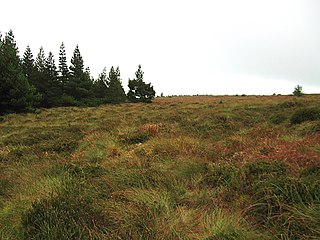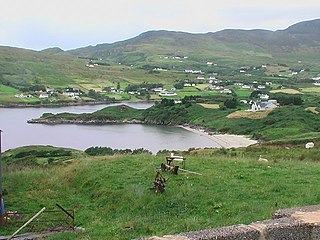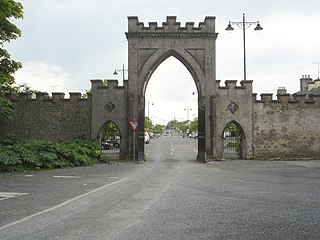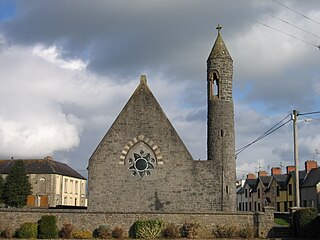Related Research Articles

Brophy is an Irish surname of ancient origin, which is derived from the Irish "Uí Bhróithe" or "Ó Bróithe" septs that were located mostly around Ballybrophy, Laois, and in counties Carlow and Kilkenny. The family has been prominent in the history of Ireland for nearly 1000 years and has included petty kings (Rí), clerics, soldiers, and writers. The family was first mentioned in the late 11th century, but as a member of the Dál Birn dynasty, its semi-legendary genealogy stretches back to AD 200 according to the Bodleian Library, MS Rawlinson B 502. As such, it remains one of Ireland's oldest extant pre-Norman Conquest noble families.
Seán Mór Ó Dubhagáin was an Irish Gaelic poet.

Mac Amhlaoibh and Mac Amhalghaidh are two different Gaelic patronymic names with different origins and meanings, but which share the same or similar Anglicisations. These Gaelic names are borne by at least three unrelated native Irish clans or septs.
Irish genealogy is the study of individuals and families who originated on the island of Ireland.

Galmoy is a barony in the north western part of County Kilkenny, Ireland. It is one of 12 baronies in County Kilkenny. The size of the barony is 162.7 square kilometres (62.8 sq mi). There are 12 civil parishes in Galmoy. While it is named after the village of Galmoy, today the chief town of the barony is Urlingford. Galmoy barony lies at the north-western corner of the county between Fassadinin to the east, and Crannagh to the south. It is surrounded on two sides by counties Tipperary to the west and Laois to the north. The M8 Dublin/Cork motorway bisects the barony. It is situated 121 kilometres (75 mi) from Dublin city and 131 kilometres (81 mi) from Cork city. Galmoy is currently administered by Kilkenny County Council. The barony was part of in the historic kingdom of Osraige (Ossory).
Giolla na Naomh O hUidhrin, Irish historian and poet, died 1420.
The O'Clery Book of Genealogies, also known as Royal Irish Academy Ms. 23 D 17, was written by Cú Choigcríche Ó Cléirigh, one of the Four Masters, who was transported in the 1650s to Ballyacroy, County Mayo, "under the guidance of Rory O'Donnell, son of Col. Manus O'Donnell, slain at Benburb, 1646."
Tuilleadh feasa ar Éirinn óigh is a medieval Gaelic-Irish topographical text, composed by Giolla na Naomh Ó hUidhrín.
O'Heerin is an Irish surname meaning "grandson or descendant of Uidhrin". The O'Heerin clan of Leinster originates in the ancient Kingdom of Uí Failghe corresponding to the modern County Offaly, the territory given by the second-century king Cathair Mór to his eldest son Ros Failgeach.

Fassadinin, sometimes written Fassadining, is a barony in the north of County Kilkenny, Ireland. It is one of 12 baronies in County Kilkenny. The size of the barony is 276.2 square kilometres (106.6 sq mi). There are 19 civil parishes in Fassadinin. The chief town today is Castlecomer. The N78 Kilkenny/Athy road bisects the barony. Fassadinin is currently administered by Kilkenny County Council.
Fearghal Mág Samhradháin, was chief of the McGovern Clan and Baron or Lord of Tullyhaw barony, County Cavan from 1359 until his death in 1393.

Upper Woods or Upperwoods is a barony in County Laois, Ireland.

Stradbally is a barony in County Laois, Ireland.

Clarmallagh is a barony in County Laois, Ireland.

Cullenagh or Cullinagh is a barony in County Laois, Ireland.

Tinnahinch is a barony in County Laois, in Ireland.

Moycarn is a barony in County Roscommon, Ireland.

Roscommon is a barony in County Roscommon, Ireland.

Ballintober North, also called Ballintober East, is a barony in County Roscommon, Ireland.

Clandonagh is a barony in County Laois, Republic of Ireland. A barony was a historical subdivision of a county; mainly cadastral rather than administrative.
References
- Topographical Poems by Seaán Mór Ó Dubhagáin and Giolla-Na-Naomh Ó Huidhrín, ed. James Carney, Dublin Institute for Advanced Studies, 1943.